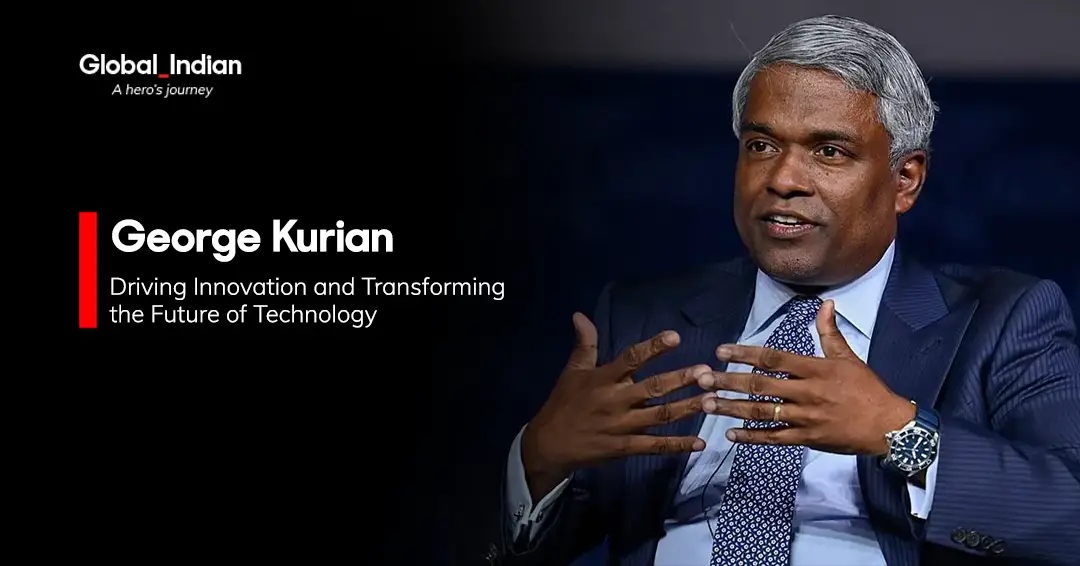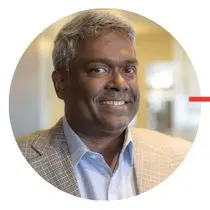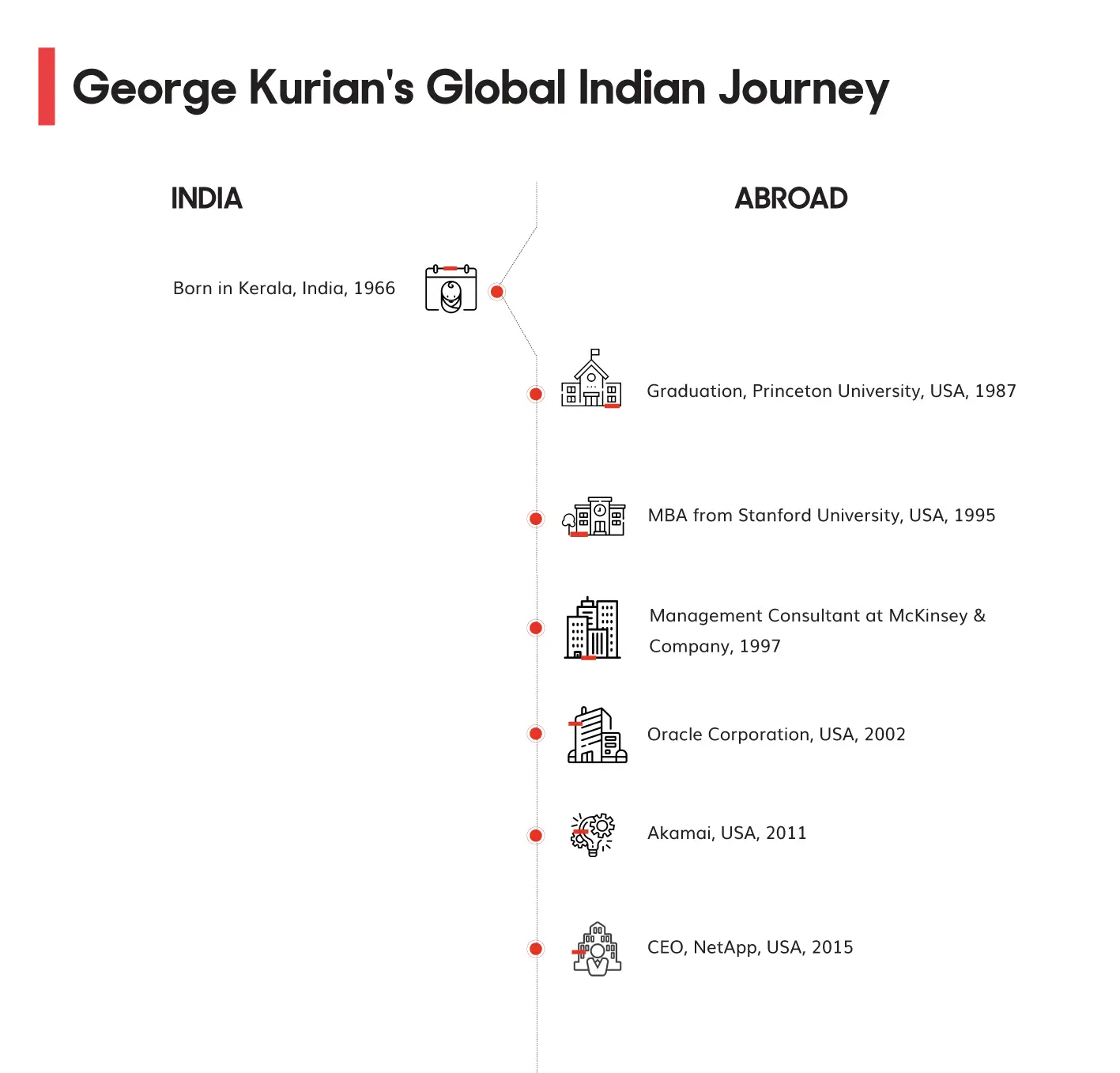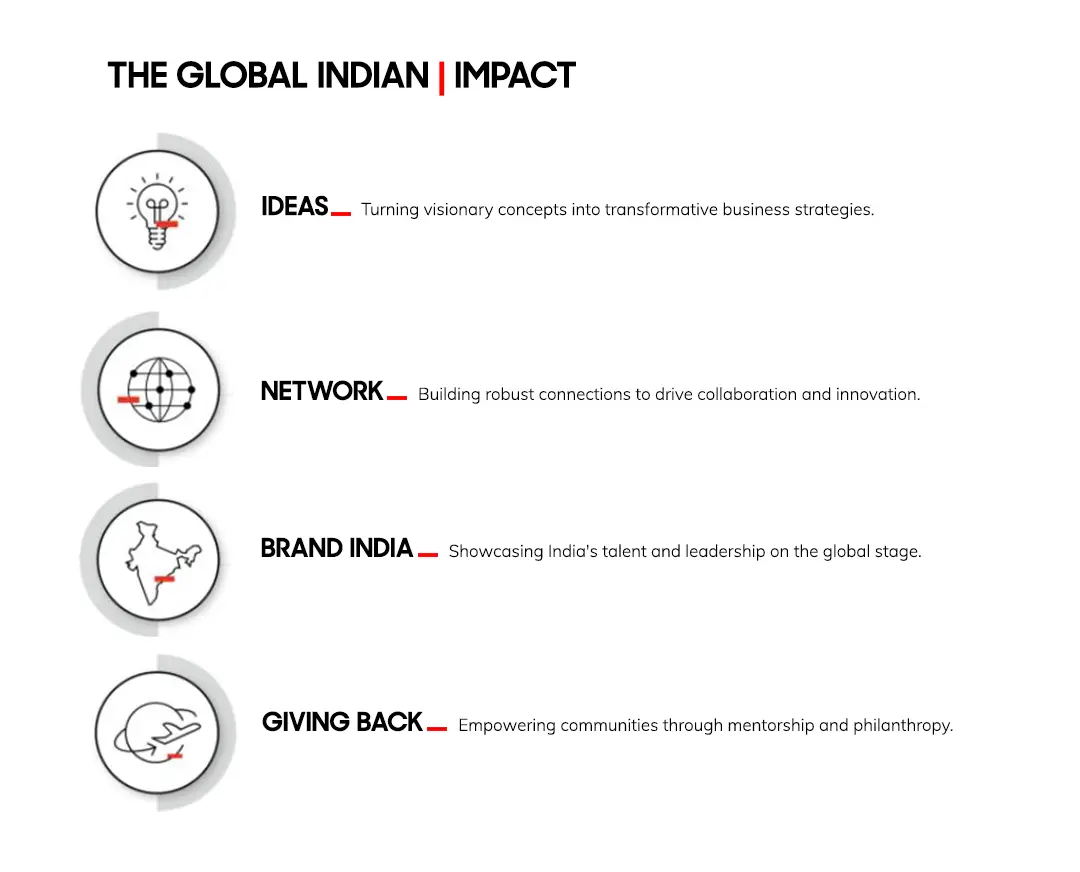
George Kurian
George Kurian’s tech trip started in an unexpected way. He never saw a computer until he turned 17. Born in Kottayam district, Kerala, India, Kurian now leads as one of just nine CEOs of Indian origin at major technology companies. His story shows what determination and flexibility can achieve.
George Kurian’s education shaped his success story significantly. His credentials include an electrical engineering degree from Princeton University and a Stanford Graduate School of Business degree in 1995. His twin brother Thomas Kurian leads Google Cloud as CEO, which creates a rare family connection at tech’s highest levels.
CEO’s | Actors | Politicians | Sports Stars
Kurian joined NetApp in 2011 and became CEO in 2015. He has steered the company in new directions while earning a base salary of $9,491,210. The company now focuses on cloud-first business models and strong data management for AI implementation. Kurian points out that large enterprises still have 85 to 90% of their data unstructured. His company helps organizations tackle these challenges head-on.
“For while change can be difficult, if we treat it as a familiar constant in life, we can spot open windows of opportunity where we might have seen closed doors of despair.”

From Kerala to Princeton: George Kurian’s Early Life
Growing up in Kottayam, India
Humble beginnings in Kerala shaped George Kurian’s worldview well before he took the helm at NetApp as CEO. He was born in the scenic district of Kottayam in Kerala, India, in a setting that couldn’t be more different from the tech hubs he would later lead. His childhood home sat in a region famous for its green landscapes and deep respect for education. George and his twin brother Thomas lived a middle-class life that put academic excellence and strong moral principles first.
Education as the life-blood ran deep in the Kurian household. Resources were scarce compared to what they would find in America, but both brothers showed remarkable academic talent early on. Their schooling in Kottayam built a strong base that would help them reach top global institutions. The brothers studied at Kottayam’s Mahatma Gandhi University, where teachers and classmates quickly noticed their sharp minds.
Twin aspirations defined the Kurian brothers’ youth. All the same, despite sharing similar DNA and academic gifts, George and Thomas grew into unique individuals with different ways of tackling problems. These distinct traits would later guide them to parallel paths in tech—George to NetApp and Thomas to Oracle and then Google Cloud. Their mix of rivalry and support started during these early years in Kerala.
First encounters with technology
A late introduction to computing marked George Kurian’s tech journey. He didn’t see his first computer until age 17—quite different from today’s tech leaders who start coding in grade school. This late start makes his rise to leading a premier data management company even more remarkable. His delayed exposure to tech didn’t stop him from mastering complex technological concepts.
Resourcefulness beat limitations in his early years. Despite the lack of technology in Kerala during his childhood, Kurian developed problem-solving skills that became great assets in his tech career. His analytical thinking and math skills grew strong even without early computer access. His education focused on basic scientific principles that laid groundwork for his later grasp of technology.
Princeton brought a technological awakening for George. His exceptional grades earned him a chance to study at Princeton University—a turning point that would change his connection with technology. He dove into an electrical engineering degree and immersed himself in computing systems he had never seen before. This time bridged the gap from tech novice to someone who could grasp complex systems at their core.
The influence of family and faith
Parental guidance molded George Kurian’s character and dreams. His father’s work as an accountant taught him financial wisdom and professional integrity—traits that shine through in his NetApp leadership. His mother made sure both sons got the best education possible, often putting their needs before her own. They created a home where excellence wasn’t just expected—it was the natural outcome of hard work.
Christian values formed the heart of the Kurian household. Growing up in Kerala’s vibrant Syrian Christian community, George built a moral compass that still guides his personal and business choices. These deep faith principles—honesty, integrity, service, and humility—shape his leadership style and business ethics today. On top of that, these values help him stay grounded during tough career shifts.
Cultural adaptability became George’s strength. His Kerala upbringing, mixing traditional values with forward-thinking education, prepared him for future cultural shifts. This skill proved vital when he moved from India to America for college, letting him keep his core values while grabbing new chances. So this talent has helped him throughout his global business career, especially when leading NetApp through major changes.
Education and the American Dream
George Kurian’s Educational Trip
Princeton and beyond marked the start of George Kurian’s academic adventure in America. George Kurian and his twin brother Thomas left India at 17 after getting partial scholarships to Princeton University. Both brothers got into the prestigious IIT Madras first. They chose to study abroad instead of staying in India. George earned his Bachelor of Science in Electrical Engineering. He went on to complete his education at Stanford Graduate School of Business in 1995. His mix of technical and business education became the foundation for his future leadership at NetApp.
Academic excellence shaped George’s time in school. The brothers showed exceptional academic skills at Princeton. One account mentions Thomas graduated with “summa cum laude” (highest honors) in electrical engineering, while George came in second. The twins shared a competitive yet supportive bond throughout their studies. Their rigorous academic work prepared George to think analytically and solve problems – skills he would later use as NetApp’s CEO.
Technical foundation from Princeton gave George key insights he would need to lead in data management. His electrical engineering degree helped him understand the technology behind modern computing systems. The Stanford MBA added business skills to his technical knowledge. These educational experiences helped him guide a technology company through major changes.
Adapting to life in the U.S.
Cultural transition tested the Kurian brothers when they arrived in America. Moving across the world at 17 meant adapting quickly, especially coming from Kerala, India’s distinct culture. George said having his brother helped: “It was a good thing that we came together. It gave us a friend to guide the big cultural transition between India and the US”. Their support for each other brought stability during this big change.
Partial scholarships made their American education possible. Unlike many wealthy classmates, the Kurian brothers managed with limited money. This experience taught them to be resourceful and determined – traits that would define George’s leadership at NetApp. Money challenges during school likely shaped his practical business approach that helped in corporate leadership.
Finding community helped them adapt successfully. The brothers built relationships with international students and others at Princeton. These early connections proved valuable as both brothers became known for building relationships in tech. George’s skill in connecting across cultures became one of his strongest professional traits.
Supporting his twin brother Thomas Kurian
Parallel trips marked the twins’ education and early careers. Both studied electrical engineering at Princeton and got MBAs from Stanford. Though they later took different career paths, their shared education gave them common ground. After graduation, George joined Oracle while Thomas became a consultant at McKinsey. They helped each other through these changes.
Career switch experiment happened in 1996 when the brothers traded jobs. George went to McKinsey, and Thomas joined Oracle. George explained: “It wasn’t that we intended to do that. It’s just that we both had good experiences and were interested in trying it out”. This unique move showed how they learned from each other and adapted professionally. This time helped both brothers develop skills they would need as executives.
Twin support system remained key as their careers grew. Having someone who understood their culture and professional challenges gave them an edge. They could give each other honest advice as they climbed the corporate ladder. Today, they lead major tech companies – George at NetApp and Thomas at Google Cloud – showing remarkable success in technology.
Climbing the Tech Ladder
Early roles at Oracle and Akamai
Building fundamental skills started with George Kurian’s entry into the tech world at Oracle Corporation. He led software engineering and product management teams after completing his education. His time at Oracle taught him to write code, test it, and deliver products to customers. He learned “what it takes to build a good product” and understood customer needs. His next step took him to McKinsey & Company as a management consultant, where he helped tech clients improve their business strategies.
Expanding his expertise, Kurian became Vice President at Akamai Technologies and took charge of product development and marketing strategies. His leadership improved the company’s content delivery network services by a lot, which showed his growing skills in strategic tech management. His career path then led him to Cisco Systems as vice president and general manager of the Application Networking and Switching Technology Group. This move added depth to his experience across tech domains.
Pursuing an MBA at Stanford
Educational advancement took shape at Stanford University’s Graduate School of Business, where Kurian earned his MBA in 1995. Stanford’s business education went together with his Princeton technical background. This combination proved valuable in his future executive roles. His post-MBA career showed his adaptability through work in consulting, software development, and network infrastructure.
Career flexibility became Kurian’s trademark experience, shaped in part by family guidance. He shared, “My eldest brother and my dad were both mentors to us and their feedback… was that in the early part of your career you want to broaden your experiences”. Their advice pushed him to explore multiple areas of the tech industry instead of focusing too narrowly.
Joining NetApp and rising to CEO
Strategic entry began at NetApp in 2011 when Kurian stepped in as Senior Vice President of the Storage Solutions Group. His role focused on the solutions portfolio and joint partner tech integration. His leadership stood out as he brought “passion and relentless focus on execution” to his work.
Rapid advancement came when Kurian earned promotion to Executive Vice President of Product Operations in September 2013. He took charge of the product roadmap and engineering for the Data ONTAP operating system—”the world’s most widely deployed branded storage operating system”. His success made him a core leader in the company.
Culminating achievement arrived in June 2015 with Kurian’s appointment as NetApp’s CEO. He reached the company’s highest position just four years after joining. Kurian shared his leadership vision: “A CEO’s role is an extension of that to its ultimate form, where you are leading a highly cross-functional team of folks to deliver great outcomes for the customer”. His guidance would later start NetApp’s transformation toward a cloud-first business model.
Leading NetApp Through Change
George Kurian CEO NetApp strategy
Visionary redefinition became George Kurian’s trademark after he took NetApp’s helm in June 2015. His leadership has taken NetApp beyond its identity as a storage company. “We are the intelligent data infrastructure company. Period,” Kurian emphatically states. This new direction shows his understanding that “storage without intelligent data services is of diminishing value to customers”. His strategy tackles three major market changes: unifying data for AI applications, integrating cloud into IT architectures, and meeting intelligent data governance needs.
Data fabric and cloud-first transformation
Pioneering data fabric stands as Kurian’s biggest breakthrough at NetApp. The Data Fabric strategy, introduced about five years ago, has grown from “a great vision” to “a full solution portfolio that is now driving big benefits for customers”. Organizations now see that “a data fabric can be the underpinning strategy that will allow them to go cloud first where it makes sense”. NetApp has kept its founding values throughout this change. The company still wants to enable its customers’ success and build “a bigger pie with others that we can share instead of trying to build a smaller one that we can control ourselves”.
Tackling AI and data management challenges
AI infrastructure innovation lies at the heart of Kurian’s vision for NetApp. Large enterprises have “about 85 to 90% of their data is unstructured,” which creates huge opportunities for generative AI applications. NetApp now focuses on three key AI strategies: adding intelligence to infrastructure and data, creating better infrastructure for AI use cases, and controlling security over data lifecycles. These efforts address what Kurian sees as a critical issue: “AI systems are being built, often in silos… with no data, and without data, the systems are useless”.
Making tough leadership decisions
Decisive leadership philosophy shapes Kurian’s approach to difficult choices. “You can’t shy away from those decisions, because if you shy away from them you end up reducing the company into mediocrity,” he explains. He supports “leaning in” on tough choices while showing empathy: “put yourself in the person impacted’s shoes”. Without this approach, he believes, you “dis-empower everybody below you”. This balanced viewpoint has helped Kurian guide NetApp’s major transformation while preserving the company’s core values and culture.
From Indian to the World

Giving Back and Staying Grounded
Supporting his childhood school in India
Childhood memories propel philanthropy as NetApp CEO George Kurian maintains strong ties to his roots in Kerala. He helps the school he attended as a child and has made it his mission to provide students with daily hot meals. This effort holds special meaning since his father never had access to such simple necessities during his childhood. His initiative pays tribute to his father’s memory and shows Kurian’s conviction that successful people should help others. “We’ve always believed that it’s the responsibility of those that have been given a lot to give back and help,” Kurian explains about his charitable work.
Mentoring young professionals
A growth mindset shapes George Kurian’s leadership approach to mentorship. “I always believe in what people call a growth mindset that talent and success is not determined by your innate ability but by persistence and getting up and trying new things and not being afraid to fail,” he shares. This philosophy translates into his active support of diversity and inclusion initiatives at NetApp, creating opportunities for underrepresented groups in technology. His dedication goes beyond corporate programs as he personally mentors aspiring professionals, especially in emerging markets.
Balancing family, faith, and leadership
Life’s personal journey guides Kurian’s approach to balance. “One of the beautiful things about life is that upon reflection, each individual sees a tapestry of their own design. Focus on painting your life with colors of your own choosing, and remember to cherish the truly important things in life, like family,” he advises. His Syrian Christian upbringing in Kerala taught him values that still shape his leadership philosophy—focusing on integrity, service to others, and humility.
Impact on the Industry
Practical innovation defines Kurian’s influence on the technology sector. “Innovation is born of imagination molded by pragmatism. The heart of innovation: bringing customer problems to talented people who have the aspiration to solve them,” he states. Despite his professional achievements, his parents remain his greatest influence. “I must give credit to my parents. I think they were both phenomenal role models, self-starters. They came up from poor backgrounds and made extraordinary contributions to their communities”.
Key Takeaways
Resilience through challenges stands as one of Kurian’s valuable lessons. “We all have bad days, when you didn’t give of your best self and you feel like you let yourself down, but the good thing about life is that the sun goes down and comes up on a new day”. His ongoing support for education and enablement continues to inspire many people who, like him, rose from modest beginnings to achieve success. George Kurian shows through his corporate leadership and personal example that true success means helping others rise with you.
Global Indian Impact Analysis

Also Read: Journey of Ganesh Moorthy, Sridhar Vembu
FAQ:
What is George Kurian's estimated net worth?
George Kurian’s estimated net worth is at least $35.50 million, primarily attributed to his role as CEO of NetApp and the ownership of approximately 292,778 shares of NetApp stock. He also earns a base salary of $1.46 million annually, along with performance-based bonuses and stock options. His financial success reflects his leadership in transforming NetApp into a leading data management and cloud services company. Additionally, his early career roles at companies like Oracle, McKinsey, and Akamai Technologies contributed to his professional and financial growth. Kurian’s wealth underscores his impact on the technology industry and strategic innovation at NetApp.
Who are George Kurian's family members?
George Kurian comes from a disciplined and supportive family in Kerala, India. His father, P.C. Kurian, was a chemical engineer, and his mother, Molly, was a homemaker who emphasized the value of education and integrity. George has an identical twin brother, Thomas Kurian, who is the CEO of Google Cloud. Both brothers followed similar paths, excelling in the technology sector. Their upbringing played a significant role in shaping their work ethic and ambition. While George focuses on his professional endeavors, he maintains a deep connection to his family, who continue to inspire his leadership and values.
What is George Kurian’s nationality?
George Kurian is Indian-American. Born in Kerala, India, he grew up in a culture that values education and discipline. At the age of 17, he moved to the United States to pursue higher education, earning degrees from Princeton University and Stanford University. His dual identity allows him to draw from the cultural richness of his Indian heritage and the innovation-driven ethos of Silicon Valley. Kurian’s journey showcases the global influence of Indian-origin professionals excelling in the technology industry. As an Indian-American, he embodies diversity and serves as a role model for aspiring leaders around the world.
Is George Kurian married?
Yes, George Kurian is married to Signe Kurian. The couple lives in the San Francisco Bay Area and has two children. While Kurian keeps his personal life private, he often highlights the importance of family in maintaining balance and perspective amid the demands of his career. His disciplined upbringing and strong values are reflected in his ability to harmoniously integrate family life with his professional responsibilities. Kurian’s personal life remains a grounding force that supports his role as a leader, demonstrating how successful executives can manage their personal and professional lives effectively.
Where did George Kurian receive his education?
George Kurian earned a Bachelor of Science in Electrical Engineering from Princeton University and later obtained an MBA from Stanford University. Before moving to the U.S., he attended the Jesuit-run St. Joseph’s Boys High School in Bangalore, India. His education provided him with a strong technical foundation and enhanced his strategic thinking skills. At Princeton, Kurian developed his problem-solving capabilities, while his MBA from Stanford equipped him to manage complex business challenges. These academic experiences shaped his ability to lead innovative projects and large organizations, playing a critical role in his professional success and influence as a tech leader.
What is George Kurian’s impact on NetApp?
George Kurian has had a transformative impact on NetApp since becoming CEO in 2015. He shifted the company’s focus from traditional storage to hybrid cloud and data management, enabling businesses to manage and secure their data seamlessly. Kurian launched innovative solutions such as NetApp Cloud Volumes and fostered partnerships with cloud giants like AWS, Microsoft Azure, and Google Cloud. He also emphasized operational efficiency and customer-centric strategies, resulting in sustained revenue growth and competitive positioning. His vision and leadership have solidified NetApp as a leader in the rapidly evolving tech industry, ensuring its relevance and success in the cloud era.
How are Thomas and George Kurian similar?
Thomas and George Kurian, identical twins from Kerala, India, are both prominent leaders in the technology sector. George is the CEO of NetApp, while Thomas leads Google Cloud. Both pursued higher education in the U.S., with George attending Princeton and Stanford, and Thomas studying at Princeton. They share values of discipline, innovation, and a commitment to excellence, shaped by their upbringing in a family that emphasized education and integrity. While they lead in different domains, their careers highlight the impact of a strong foundation and the ability to navigate and excel in highly competitive industries.
What were George Kurian’s early career roles?
Before joining NetApp, George Kurian built a diverse career across several leading organizations. He began at McKinsey & Company as a management consultant, advising technology clients on business strategies. At Oracle Corporation, he held leadership roles in software engineering and product management, contributing to innovations in enterprise software. Later, as Vice President at Akamai Technologies, he oversaw product development and strategy, focusing on enhancing content delivery networks. Kurian’s early roles provided him with a deep understanding of technology, customer needs, and business dynamics, preparing him for his future leadership at NetApp and success in the tech industry.
What is George Kurian's salary?
As the Chief Executive Officer and Director of NetApp Inc., George Kurian’s total compensation for the fiscal year 2024 was $17,741,459. This package included a base salary of $1,000,000, a bonus of $2,350,726, stock awards valued at $14,377,251, and other compensation amounting to $13,482. This information is based on proxy statements filed for the 2024 fiscal year.
How old is George Kurian?
George Kurian was born in 1967 in Kerala, India, making him 57 years old as of 2024. He holds a Bachelor of Science degree in Electrical Engineering from Princeton University and an MBA from Stanford University. Before becoming CEO of NetApp in 2015, Kurian held various leadership roles, including positions at Cisco Systems and Akamai Technologies.




